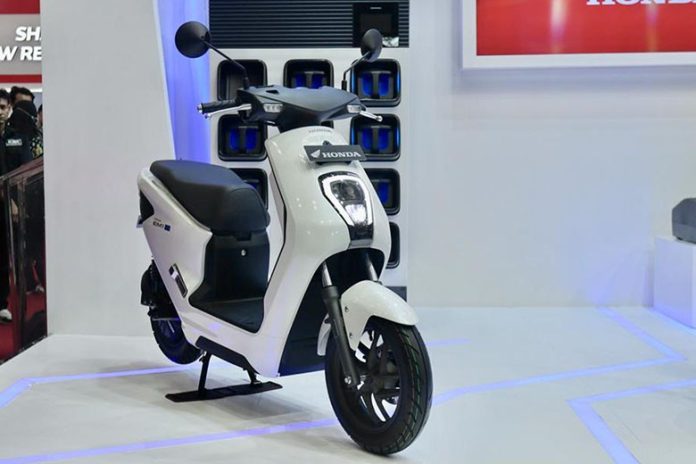Honda’s new emission-free 2023 Honda EM1e E-Scooter is designed for life in the city, with features including simple operation, compact size, and quick charging. The EM1 e gives you a sense of adventure, efficiency, and newfound independence, whether you’re zipping to class or cruising to meet friends for coffee.
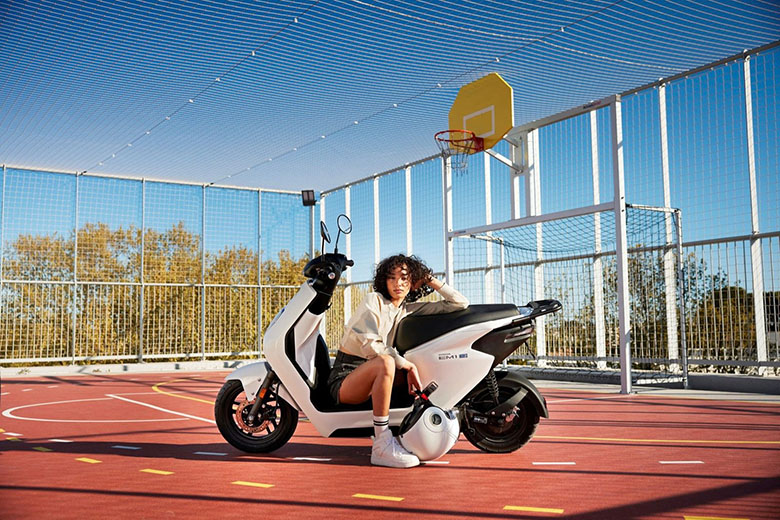
2023 Honda EM1e E-Scooter – Features and Specs
Range
On full charge, the vehicle’s range is 41 kilometers. 160 minutes to charge from 25 percent to 75 percent. 2,500+ years of useable life.
The first Honda EV aimed towards teenage riders in Europe has arrived. Powered by a removable Honda Mobile Power Pack e, the EM1 e provides enjoyable, emission-free urban transportation with genuine convenience. The propulsion is offered by an electric motor housed inside a wheel, and the vehicle can reach up to 45.0 km/h. Pillion-foot pegs, a rear carrier, and a digital instrument display are available extras.
The EM1 e, scheduled for delivery in the summer of 2023, will be Honda’s first electric two-wheeler for European consumers and the first model to be revealed after the company announced ambitions to offer ten or more electric motorbike models worldwide by 2025. It’s a big first step toward Honda’s goal of making their whole motorbike lineup carbon-neutral by 2040.
The Electric Moped (thus the ‘EM’) is designed specifically for the young professional or college student who wants a fun and convenient means of getting about town. Its small size, level floor, and refined design set it apart from the rest of Honda’s lineup. The EM1 e: is ideally in step with contemporary standards for urban transportation, making quick trips around town and longer commutes to work or school efficient, quiet, and emission-free.
The Honda Mobile Power Pack e: is what gives the EM1 e: its power, and it is constructed with an unwavering commitment to longevity, dependability, and quality. The Mobile Power Pack (MPP) has been built to endure changes in temperature, humidity, impact, and vibration and provides a riding range of more than 40 kilometers on a single charge. The MPP is a removable battery pack that can be swapped out of the EM1 e and charged in your time and space.
After announcing in September 2022 that it will release ten or more electric two-wheelers worldwide by 2025, Honda has finally released its first two-wheeled electric car for European customers: the EM1 e. It’s also an essential first step toward Honda’s goal of producing carbon-neutral motorbike lines by 2040.
The ‘EM’ designates this model as an electric moped, and its target market is young people who are interested in inexpensive, pleasurable, and environmentally friendly means of getting about town. Its small size, level floor, and sleek design set it apart from the rest of Honda’s lineup.
The EM1 e: is in perfect harmony with contemporary standards for urban transportation, making short trips about town and commutes to work or school effortless, silent, and emission-free.
As parking regulations become more severe in European cities, it’s no surprise that demand for electric vehicles (EVs) is rising. Honda is the latest company to provide a new, high-quality option for teenage riders and urban commuters.
The EM1 e: is enticing because it is easy to ride and manage, quiet, and environmentally-friendly transportation for a typical student, who may complete a total ‘lap’ of the city of 30 kilometers on an ordinary day.
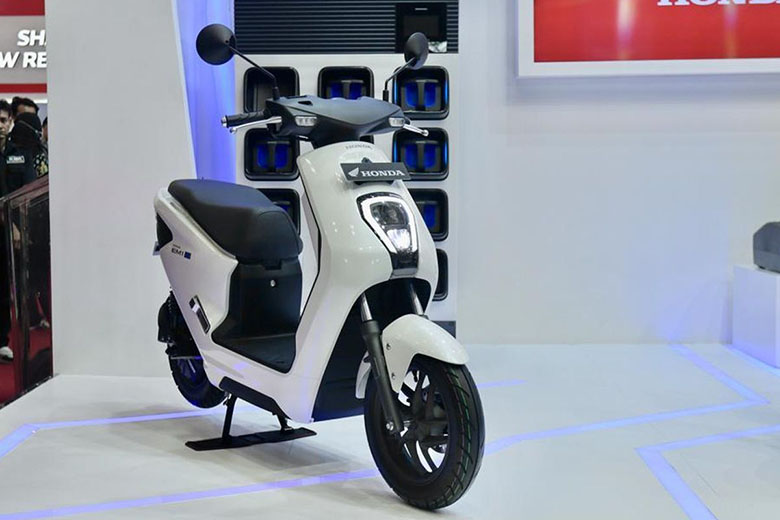
The first of many, hopefully.
The EM1’s easy-rider step-through design, flat floor, and low seat make it suitable for riders of varying heights and builds.
Easy to charge
The 10.2-kilogram battery pack is easily removable for charging wherever it is most convenient.
Low Maintenance
Because there is no need to change the oil or a filter on an electric motor, maintenance and replacement expenses are minimized.
Freedom to Move
Get rid of your cab and rail applications; the EM1 e: will let you own the city.
Peace of mind
Honda’s engineering has been tried and true for decades, and its products reflect it.
Cheaper to run
The EM1 e: is less expensive than driving or using the bus.
Sustainable Battery Ownership
Honda aspires to have its name recognized as a motivating and inspiring force. Helping individuals all around the globe who are taking action on their own accord is a great way to unleash their full potential. Honda aims to have a “zero environmental footprint” so that more people may experience “the joy and freedom of mobility.”
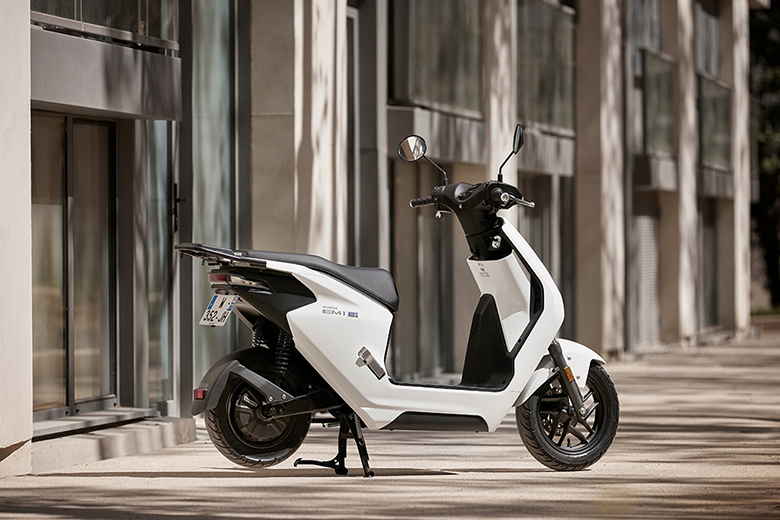
Honda plans for a carbon-free future by embracing a circular society with several solutions. For long-term battery sustainability, we’ll think about the Honda Mobile Power Pack’s whole life cycle—from manufacturing to ownership to recycling.
Battery & Charger
The 50V Honda Mobile Power Pack drives the EM1 e: designed in-house by Honda with the same unwavering dedication to durability, dependability, and quality for which the company’s internal combustion engines are famous.
The Honda Mobile Power Pack e: is built to withstand changes in temperature, humidity, impacts, and vibrations, and it provides a usable riding range of 41.3km or approximately 48.0km in ECON mode under Honda’s internal test conditions (30km in WMTC Class 1 testing conditions).
The Honda Mobile Power Pack e: as the name indicates, is a removable battery that can be swapped out of the EM1 e: and charged independently. The charger requires a single-phase AC100-240V home power supply and can generate 270W at most. The charger has a total mass of 5.3kg, and its LED indications provide a 4-stage breakdown of the charging process. The Honda Mobile Power Pack weighs about 10 kg and has an ergonomic handle that makes it simple to transport and swap out.
It usually takes about 6 hours to charge completely, but just 2.7 hours (160 minutes) to charge from 25% to 75%. Due to Honda’s legendary reliability, the Honda Mobile Power Pack can be recharged more than 2,500 times (under internal testing conditions).
The in-wheel motor has a 0.58kW output rating and a max power of 1.7kW. The ECON setting lowers power output to 0.86 kW. The EM1 e: can reach up to 45 km/h and carry 75 kg up a slope of up to 10 degrees. In ECON mode, the throttle response is sluggish, and the maximum speed is lowered, increasing the effective range to about 48 kilometers.
Styling & Equipment
The EM1 e was designed to visually contrast with its internal combustion engine (ICE) relatives, so it’s relatively small and svelte, with a front end that’s all-soft curves and a back end that’s all-sharp angles.
The scooter’s 12V battery powers its electronics, including its LED lights. All the pertinent data, such as the battery’s remaining charge %, is shown clearly on a straightforward digital dashboard.
Under the seat is 3.3 liters of storage space, and the fairing’s front left inner pocket is big enough to hold a 500 ml PET water bottle; the fairing’s right side has a USB outlet for charging a smartphone. The pillion passenger has access to grab rails and a hook to store their belongings.
Pillion-foot pegs fold neatly into the bodywork when not in use, and a rear carrier is included as standard equipment.
The back carrier and top box, totaling 35 liters of space, will be sold separately.
Chassis
Although the EM1 e: has many novel features, its chassis is a tried-and-true design that is both functional and comforting, lightweight and robust, and simple and confident to drive. Its length is just 1,860 millimeters, and its seat height is only 740 millimeters, making it very portable. The vehicle has a respectable 135mm of ground clearance and weighs just 95kg with the batteries.
The frame is an under-bone construction made of steel, and it has dual shocks in the back with double tube dampers and 31mm telescopic forks up front. The wheelbase is 1,300mm, while the rake and trail are 27 degrees and 77 millimeters, respectively.
Front tires are 90/90-12 inches and rear tires are 100/90-10 inches. The front wheel is cast aluminum, while the back is a mix of aluminum and steel. The Combined Brake System (CBS) interconnects the front disc brake with a 190mm/single-piston caliper with the rear drum brake with a 110mm diameter, allowing for precise braking control. CBS transfers force to the front caliper when the rear brake is applied.
No noise pollution
With an electric motor, your commute or commute home will be much less noisy.
No vibrations
The quiet Honda electric motor keeps the grips comfortable.
Easy to Handle
Small, lightweight, and simple to maneuver through congested city streets.
LED Lighting
You may safely go out in the evening because of the high visibility provided by the bright LED illumination.
Tight turns
The tiny footprint allows for precise maneuvering at low speeds.
Front Inner Pocket
The left chest pocket is a great place to stash your 500ml water bottle.
Electric Motor
The Honda electric motor provides 1.7 kilowatts of power and 90 newton-meters of torque, allowing for swift takeoff from a stop.
Riding Modes
To get the most out of your trip, decide between Standard and Econ modes.
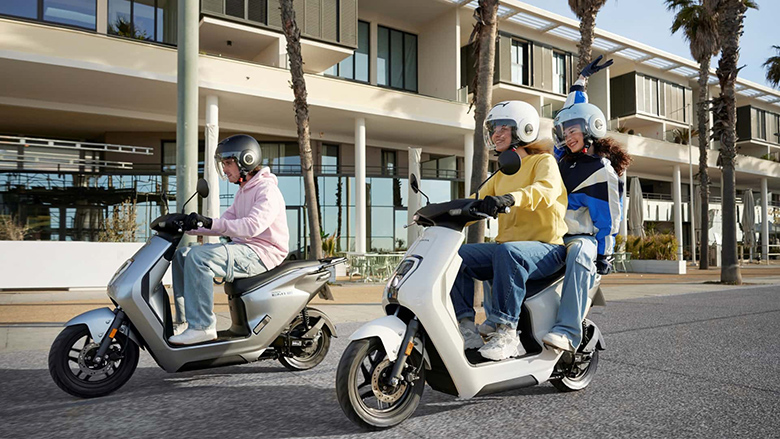
The Honda EM1’s digital gauge cluster.
The LCD digital display provides all the navigational data you’ll need to travel about town, including speed, range, mode, and battery percentage.
USB Type-A socket
There’s a USB Type-A port in the bag to keep your gadgets powered up on the move.
Rear carrier
Standard equipped with a large back rack, perfect for securing your exercise bag or Friday night’s takeout.
2023 Honda EM1e E-Scooter – Technical Specifications
Motor
| Electric motor type | In-wheel 3-phase brushless motor |
| Top Speed | 45km/h |
| Maximum Power | 1.7kW |
| Maximum Torque | 90.0Nm |
| Range (per Mode) | WMTC Mode (Class 1) – 30.0km |
| Usable range (internal testing conditions) | 41.3km |
| Functional capacity in ECON mode (internal testing conditions) | 48.0km |
| Energy Consumption (WMTC Class 1) | 47 Wh/km |
Battery
| Battery type | Lithium-ion |
| Battery voltage | 50.3V |
| Battery capacity | 29.4Ah |
| Total number of battery packs | One |
| Battery fixing type | Removable |
| Battery Technology | Honda Mobile Power Pack e. |
| Battery weight | 10.3kg |
| Battery dimension | 298 mm (L) x 177 mm (D) x 156 mm (H) |
| Charger type | Off-board type. solo-phase AC100-240V 50/60Hz. |
| Charging time (0-100%) | 6 hours |
| Charging time (25-75%) | 2.7 hours (160 minutes) |
| Rated Power | 270 Watts |
| Battery Lifecycle | Over 2,500 charging cycles (internal testing conditions) |
Chassis
| Frame Type | Underbone type |
| Dimensions (L´W´H) | 1860mm x 680mm x 1080mm |
| Wheelbase | 1300mm |
| Caster Angle | 27 degrees |
| Trail | 77mm |
| Seat Height | 740mm |
| Ground Clearance | 135mm |
| Vehicle weight (with battery) | 95kg |
| Turning radius | 2.0m |
| Suspension Front | Telescopic forks |
| Suspension Rear | Twin shock |
Wheels
| Wheels Front | Cast type |
| Wheels Rear | Composite |
| Tyres Front | 90/90 – 12 |
| Tires Rear | 100/90 – 10 |
Brakes
| Type | CBS |
| Brakes Front | Disk |
| Brakes Rear | Drum |
Instruments & Electrics
| Instruments | LCD |
| Headlight | LED |
| Taillight | LED |
| USB | Yes – Type A |
| Key type | Standard |
Other
| Load Capacity | 180kg |
| Seat length | 590mm |
| Seating Capacity | 2 |
| Climbing Angle | 10°@ 75kg |

